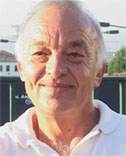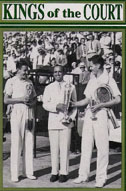Ken Rosewall: The Player
and The Backhand
By Ed Atkinson
It is a vast understatement to say that Ken Rosewall had a successful career as a tennis player.
But the one aspect of his career that was truly stunning was its longevity.
This is a player who won the Wimbledon doubles championship as an 18 year old, played a critical
role in an Australian Davis Cup victory at age 19, won the U.S. National singles at 21, and rather unbelievably,
reached the singles final at both Wimbledon and the U.S. Open while in his early 40's.
He won the Australian 4 times and the U.S. Championships and French twice. And remember this was
before the Open era. For over a decade while he was as a professional,
he was ineligible to play the Grand Slams.
 |
Rosewall's longevity of 30 years at the top of the game will never be equaled. |
Rosewall also twice won the World Professional Championships, defeating Rod Laver in two consecutive
finals--matches that are still considered classics. Throughout his career, Rosewall's calm demeanor and unfailing
sportsmanship made him a true credit to the game. There is no doubt he is worthy of the pantheon of
all time greats.
The chief reason for Rosewall's miraculously long ran was his exquisitely perfect timing. This
translated into an effortless ease. Rosewall put a minimum of strain on his body throughout a match. He could
never be accused of over-taxing his muscles, because he didn't have any. (Hence the lifelong nickname
"Muscles.") Of course the fact that his backhand drive and backhand volley are two of the greatest shots
in the history of tennis didn't hurt his chances.
Rosewall was introduced to tennis at a young age under the tutelage of the masterful Harry Hopman.
The Australian Tennis Association placed the entire future of Australian men's tennis in Hopman's gifted hands,
and did he ever deliver! What seemed to be an endless procession of champions rolled off the Hopman assembly
line, a phenomenon that was unstoppable. Hopman's method was to locate the quickest, fastest, and most agile
youths, and then teach them how to play tennis.
Rosewall's lavish athletic gifts reached Hopman's radar, and shortly thereafter, a star was born. Upon first meeting Rosewall, Hopman noted that Ken was a natural left-hander. Immediately, Hopman decided that this would never do, and from the outset, converted Rosewall into a right handed tennis player. Hopman's reasoning was based upon his observation that few if any left handers had, up until that time, become consistent winners. Ironically this conversion might help explain the excellence of Rosewall's backhand which relies on the hand eye coordination of the left side of the body.
A Personal Note
The most common method of judging an athlete's ability is through watching him compete. But you develop a far greater and deeper appreciation when you compete against him or her yourself.
 |
Harry Hopman (center) produced a seemingly endless series of champions, including our opponent's Rosewall and Hoad. |
My first opportunity to see Ken Rosewall in action was in 1951 during the Pacific
Southwest tournament in Los Angeles, in those days the most important hardcourt tournament in the world.
That year I was a ball boy for several of his matches. In subsequent years when he returned to the
tournament I had many opportunities to see him play.
Then in the 1956 tourney I had the chance to play against him myself, when my partner and
I drew Rosewall and Lew Hoad in the first round. The good news was that in 1956 my partner Bobby Delgado
and I were the top ranked junior doubles team in the country. In fact we were generally considered the
best junior pair in the world, having defeated other junior teams with players such as Rod Laver and
Rafael Osuna. That was the good news. The bad news was that in 1956, Hoad and Rosewall were the
undisputed men's champions of the world.
The match was played in front of a full house, sprinkled with motion picture superstars, as
was the norm for the era. I had the pleasure of warming up with Ken. I can honestly swear that he did not
miss one ball. Furthermore, every ball he hit landed two feet or less from the baseline.
During the match I found that his ball was quite deceptive. By this I mean that his relaxed swing made the racket appear to move slowly and, in turn, made me expect a rather easy ball. Instead when the ball hit the court it just took off. A heavy ball indeed. A chance to play a center court match against two of the great legends in the game is something you tend to remember, and I can remember every point.
Bobby and I played better than we could have possibly expected, but we eventually succumbed 6-4, 6-3, after some incredible shot making by Lew Hoad at key moments. Lew poached one of my returns and hit a swinging topspin backhand volley for a winner. I tried to drill him with an overhead, one of my favorite plays in those days, only to have him nearly take my head off with a reflex forehand volley. We left the court relieved not to have disappointed all the people in those expensive seats.
And Rosewall? After the match I asked my partner if he remembered Rosewall missing any returns on second serves. His reply was: "Now that you mention it, I don't remember him missing any." Neither did I.





